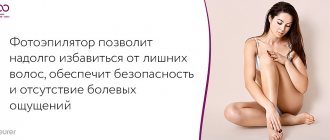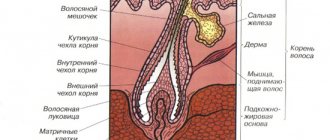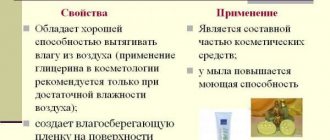Red, voluminous dots can form after a few days, when hairs that have already been thinned by manipulation (whether with a razor, sugar or wax) begin to emerge again. A thin hair under the skin forms a loop; the tip cannot break out, which can cause an inflammatory process.
Our cosmetologists know more than one solution to this problem, they will be happy to help you. But let's try to independently consider the reasons for this phenomenon and find a way out that will help you cope with the consequences of hair removal of this nature, even on your own at home.
Since hair removal is a very popular procedure, many people experience ingrown hairs after hair removal. There is nothing terrible about this if you start prevention in time. Hair most often begins to grow in on the legs and bikini area. If the process begins in the deep epilation zone, it is very unpleasant. There is no need to be shy or ashamed, as this is a common situation associated with the characteristics of the body, the structure of the hair and self-care after manipulation. At the same time, men face similar difficulties: hair can grow in the armpits, on the face (where the beard and sideburns are), and on the neck.
Make an appointment at the clinic on Vasilyevsky Island
Sign up
Signs of ingrown hairs
Symptoms of improperly growing rods appear 1-3 days after the cosmetic procedure.
Signs of ingrown hairs in the bikini area:
- growth points began to look like pimples, ulcers, bumps, bruises;
- the epilation site is swollen, red or painful;
- inflammation appeared in the bikini area;
- the skin itches or burns after treatment;
- curled hairs or dark spots are visible in the area of discomfort.
Such symptoms cannot be ignored, otherwise the problem of ingrown hair in the bikini area will have to be addressed in the hospital.
After unsuccessful hair removal, it is difficult to avoid the formation of papules (round dense balls) and purulent pimples (pustules). You can get a deformed hair from them.
Features of the bikini area
The intimate area is different from other areas where vegetation is removed.
- the hair is very coarse, especially if the lady is naturally dark or red-haired;
- the skin in the bikini area is thin, blood vessels pass close to the surface, and immediately begins to become inflamed;
- high sensitivity in the area between the legs;
- uneven surface for cosmetic procedures;
- constant contact with clothing;
- special, triangular hair structure.
Ingrown hairs are new hair shafts that, as a result of damage to the hair follicle, begin to grow not in the natural direction, but down or to the side. They need to be pulled out from under the skin. Through micro-wounds and cracks in places of growth, microorganisms enter the body, causing pathological processes. All this provokes an inflammatory process that can lead to ulcers, bumps, scars, scars and dark spots.
When epilating, a woman plans to remove hair along with the hair follicles. If something goes wrong, only the shaft and part of the follicle are torn off. As a result of mechanical damage, the position of the hair root changes, and soon a weakened hair appears, which grows not in the intended direction, but in the direction where the bulb has deviated, even growing inside the body. And those rods that do reach the skin, due to thinning, cannot penetrate the epidermis and grow under it, causing inflammation.
Which doctor should I contact?
If the condition of the skin causes concern (there are many purulent abscesses, or they increase in size, covering new areas of the skin), you need to consult a cosmetologist or dermatologist, and subsequently for surgical help.
Ingrown hair that remains under the skin is unable to resolve on its own and provokes even greater inflammation. Sometimes the abscess breaks open without help. Then the wound must be treated with antibiotics and then covered with a sterile bandage.
How to cure the effects of hair removal or ways to combat it
To prevent the possibility of an ingrown hair follicle and prevent inflammation, several skin care methods are suitable.
How to remove ingrown hairs in the bikini area, removal methods:
- scrub the skin;
- soften the skin daily with a moisturizer;
- take steaming baths;
- refuse synthetic underwear.
If you prepare in advance for hair removal and grow hairs of sufficient length, this will relieve discomfort and further unpleasant consequences.
If large bumps or ulcers appear, then you need to seek medical help. You cannot remove pus yourself. Skin diseases can only be cured by a dermatologist or surgeon.
Diagnostics
If signs of pseudofolliculitis appear, you should make an appointment with a dermatologist. The doctor will ask the patient about complaints and hair growth patterns. In most cases, an external examination of the problem area is enough to make a diagnosis, but sometimes a dermatologist needs to exclude other skin pathologies with similar signs.
Additional examinations:
- Dermatoscopy is an instrumental way of examining the skin using multiple magnification. The doctor may use a manual scope or an automated digital dermatoscope. With this examination, the dermatologist evaluates the condition of the skin and looks for specific signs of pseudofolliculitis, such as a barely noticeable tip of the hair shaft under the skin.
- Laboratory examination of the contents of the abscess. In rare cases, such a procedure is prescribed for the frequent appearance of a follicular abscess in one area. The specialist needs to clarify which pathogen is causing the infection.
During the diagnosis, the dermatologist excludes the presence of diseases such as folliculitis, pyoderma, acne and hyperkeratosis. Additional examinations can improve the treatment of the disease.
Scrub for ingrown hairs
To better remove follicles, you should treat your body with a fine-grained scrub before going to a cosmetologist. This will help combat the negative consequences of hair removal. The scrubs are simple and easy to use, after which you simply remove the crooked hairs.
Before peeling, steam the skin for 10 minutes by taking a hot bath or applying a damp hot cloth to the removal area. The water can be simply clean, or you can take herbal decoctions.
If there are purulent areas, the scrub cannot be used! You also cannot remove or squeeze out the pus yourself. This will only spread the pathological process over a larger area. This problem should be treated by a dermatologist.
Use pure medicinal herbs or mixtures thereof. Chamomile, celandine, sage, calendula 1 tbsp each. for 0.5 liters of boiling water. Simmer the mixture over medium heat for a quarter of an hour. Leave to cool to 60°C, remove the sediment and wet the fabric for a steaming compress for the bikini area. The heat prevents further damage to the delicate bikini area.
Apply the abrasive mixture to the prepared area and rub the skin with gentle finger movements. Scrub particles remove the microscopic layer of cells, making it softer and thinner; even weakened hairs will be able to break through the treated epidermis. All you have to do is remove the ingrown hair in the bikini area with tweezers. After scrubbing, the body needs to be moisturized by applying cream or cream.
Homemade scrub recipes
To combat the consequences of unsuccessful hair removal, ready-made store-bought or homemade products are suitable. Making a remedy for ingrown pubic hair in the bikini area is easy. Granulated sugar, extra salt, the remains of ground coffee after brewing, finely ground bran, badyagu, grain flakes, and ground medicinal herbs are used as an abrasive. Mix the abrasive component with the viscous base 1:1. The basis is shower gel, cosmetic cream, liquid cream, skin oil.
Such homemade scrubs will help bring the skin back to normal, as in addition to the exfoliating effect, they have a moisturizing, nourishing and anti-inflammatory effect. And herbs will complement the treatment. If you add 1 tsp to the scrub. baking soda, the product is suitable for thick and hard skin. After this, the deformed hairs can only be pulled out with a pin or needle.
Coffee-coconut scrub
This product contains coconut oil, ground coffee, coconut flakes, granulated sugar, and extra salt. Heat the oil until viscous in a water bath. Add the necessary components 1:1, mix thoroughly, cool. To improve the aroma, add cinnamon or vanilla crumbs.
Gentle herbal peeling
The composition includes refined (50 ml) and flavored (1-2 drops each) oils, lemon juice (20 drops) plus ground medicinal herbs and candied honey. The remaining components are mixed in equal proportions and applied to the desired area. This recipe allows you to combine treatment and care.
Healing aloe scrub
Aloe juice or puree (50 g) is mixed with the same amount of coarse corn flour or semolina. This product is delicate, good for the skin, allows you to pull out crooked hairs without discomfort and get rid of wounds.
Read also: Pain-relieving creams and folk remedies for hair removal of the bikini area at home
Homeopathic remedies
Homeopathic remedies should be chosen with caution as they may cause an allergic reaction. In addition, a product not intended for the intimate area can disrupt the microflora.
In any case, before using the product, it must be tested to see if it will cause an allergy. The product should have an anti-inflammatory effect, relieve swelling, accelerate tissue repair and have an antipruritic effect.
An effective homeopathic remedy is Natur 2 GUNA cream. It is intended directly for treating the intimate area, so it does not disturb the microflora, improves tissue structure, promotes skin hydration, and soothes inflammation.
Arnica cream has an antibacterial effect, removes inflammation, promotes skin regeneration in case of microtrauma, and prevents the appearance of age spots.
Gel "Traumel S" is used for abscesses and inflammations. It blocks the development of infection and inflammation, has an antipruritic effect, relieves swelling, and has analgesic properties. It is necessary to treat bikinis with it from 2 to 5 times a day.
Powerful aspirin scrub
Crush several tablets of acetylsalicylic acid into grains. Add tablet crumbs to a small amount of liquid soap. Apply the paste with a light massage to the depilation area, avoiding areas with mucous membranes. After a few minutes, rinse off the mixture and wipe the treated area with 3% hydrogen peroxide. Let it dry, rinse off any remaining product, and apply nourishing cream.
Strong whitening peeling
Mix 50 g of white clay with ground parsley. Add a couple of drops of lemon juice. This composition whitens the skin well. It is applied for 10 minutes, after which it is washed off with warm water.
Pulling out lost hairs
After treating the skin with abrasives, ingrown rods will become visible. As long as the surface is steamed and cleaned, removing ingrown hair in the bikini area with tweezers is easy and painless. The damaged bulb will continue to grow a deformed hair for several months, which is pulled out with a needle.
Recommended! All instruments that come into contact with the body or wounds must be thoroughly wiped with ethanol or another antiseptic (chlorgesidine, myrimistin, hydrogen peroxide).
Skin softening
If you don’t want to deal with ingrown hairs by trying to pull them out with a pin, you can use emollients. To do this, they are applied to the bikini area, the layer of the epidermis becomes thinner, softer, easier to pull out, and the weakened rods quickly pass through the epidermis, and it is easier to get rid of them.
After any traumatic manipulation of the skin, it is necessary to use disinfectants and moisturizers, plus monitor healing for up to 7 days.
Products for softening the epidermis:
- Preparations based on salicylic acid are included in pharmaceutical ointments and cosmetic peels. The site of ingrown hair is treated with an acid solution for 2-5 days, then the hair is simply plucked out with tweezers;
- crushed aspirin tablets in glycerin (2 tablets in 1 tablespoon of oil) are applied pointwise to the ingrown areas, leaving for several hours to soften, then the hair is pulled out;
- mixtures with hydrogen peroxide. Badyagi powder (1:1) is added to the effervescent solution. The resulting composition is applied to the inflamed area for a quarter of an hour for a week or until the ingrown hair appears above the skin.
We must not forget about allergies. When planning a new product or substance, especially in such a delicate area as the bikini, you should first do an allergy test (apply the new product precisely for 20 minutes and note the reaction to it).
Risk group
It is worth noting that not all people experience pseudofolliculitis, although almost every man shaves his face, and women use various hair removal methods.
As a result of skin trauma, ingrown hairs will occur more often in those at risk. This primarily applies to people of the Negroid race and those who have coarse and curly hair. Dry skin also increases the risk of ingrown hairs.
Another category of people susceptible to this disease are those whose follicle angle is too sharp in relation to the skin. This fact also contributes to the development of pseudofolliculitis.
Treatment of dark marks from ingrown hairs in the bikini area
After the pimple and hair disappear, a dark spot may remain in its place. A large number of such blue-brown dots and spots look very ugly. You need to try to lighten them.
Ready-made creams and ointments with a whitening effect (zinc-salicylic paste, Badyagi 911 cream) are suitable for this. The drug is applied before bedtime for 15 minutes, for a week or until the darkening disappears. You can get a similar result by rubbing hydrogen peroxide on the spot, but you need to be careful not to burn the skin.
Among home remedies, parsley, milk, fruit acids and white clay have worked well. Using these products it is easy to make masks and compresses. Fruit acids are added to the composition, which will remove darkened spots, remove the rough top layer, cleanse and soften the skin. To do this you need lemon juice, green apple juice, fruit vinegar, plus a base.
An approximate recipe for a solution for whitening the body: mix white clay, an acidic component and essential oil, 1 tbsp each. Apply to problem areas for 10 minutes, rinse, apply nourishing cream.
The parsley mask consists of green gruel (it is better to squeeze the juice out of the greens), lime or lemon juice and kefir. The components are mixed 1:1, applied to the skin, a piece of cloth in this mixture on top, lie down for 20 minutes, then rinse, moisturize with cream. This recipe is also suitable for the face, but use less, you need to focus on the sensations. Wash it off if it starts to burn.
If after masks and compresses with a whitening effect it tingles, the skin can be soothed with baby cream, Bepanten or Panetnol.
Antibiotics
If an abscess begins, oral antibiotics are necessary. One of the effective ones is Cephalexin . It is taken for 1-2 weeks as prescribed by a doctor. Self-treatment can cause side effects associated with digestive disorders, low blood pressure, allergies, and reactions from the cardiovascular system.
Tetracycline is also taken orally every 6 hours, 1 tablet as prescribed by a doctor.











